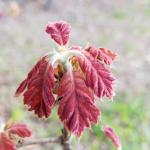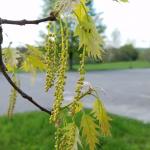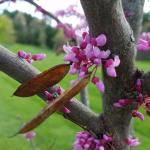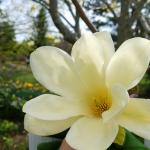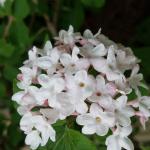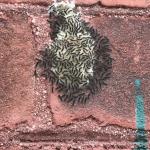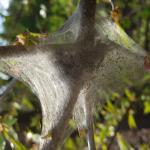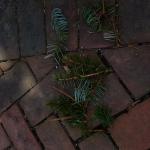UMass Extension's Landscape Message is an educational newsletter intended to inform and guide Massachusetts Green Industry professionals in the management of our collective landscape. Detailed reports from scouts and Extension specialists on growing conditions, pest activity, and cultural practices for the management of woody ornamentals, trees, and turf are regular features. The following issue has been updated to provide timely management information and the latest regional news and environmental data.
To read individual sections of the message, click on the section headings below to expand the content:
Scouting Information by Region
Environmental Data
The following data was collected on or about May 9, 2018. Total accumulated growing degree days (GDD) represent the heating units above a 50° F baseline temperature collected via our instruments for the 2018 calendar year. This information is intended for use as a guide for monitoring the developmental stages of pests in your location and planning management strategies accordingly.
|
MA Region/Location |
GDD |
Soil Temp |
Precipitation |
Time/Date of Readings |
||
|
1-Week Gain |
2018 Total |
Sun |
Shade |
|||
|
Cape Cod |
62.5 |
103 |
60 |
55 |
0.39 |
3:00 PM 5/9 |
|
Southeast |
84 |
144 |
68 |
57 |
0.28 |
5:10 PM 5/9 |
|
North Shore |
119 |
186 |
54 |
49 |
0.28 |
9:30 AM 5/9 |
|
East |
113.5 |
193 |
66 |
62 |
0.28 |
4:00 PM 5/9 |
|
Metro West |
98.5 |
145.5 |
55 |
52 |
0.51 |
6:00 AM 5/9 |
|
Central |
73 |
123 |
59 |
51 |
0.58 |
7:00 AM 5/9 |
|
Pioneer Valley |
100 |
166 |
60 |
55 |
0.34 |
11:00 AM 5/9 |
|
Berkshires |
85 |
138 |
58 |
54 |
0.62 |
9:00 AM 5/9 |
|
AVERAGE |
92 |
150 |
60 |
54 |
0.41 |
- |
|
n/a = information not available |
||||||
Phenology
| Indicator Plants - Stages of Flowering (BEGIN, BEGIN/FULL, FULL, FULL/END, END) | ||||||||
|---|---|---|---|---|---|---|---|---|
| PLANT NAME (Botanic/ Common) | CAPE | S.E. | N.S. | EAST | METRO W. | CENT. | P.V. | BERK. |
|
Syringa vulgaris (common lilac) |
Begin |
Begin |
Begin |
Begin |
Begin |
Begin |
Begin |
* |
|
Rhododendron spp. (early azaleas) |
Begin |
Begin |
Begin/Full |
Begin |
Begin |
* |
Begin |
* |
|
Cornus florida (flowering dogwood) |
Begin |
Begin/Full |
Begin/Full |
Begin/Full |
Begin |
Begin |
Full |
Begin |
|
Malus spp. (crabapple) |
Begin |
Full |
Begin/Full |
Begin/Full |
Begin/Full |
Begin/Full |
Full |
Begin |
|
Cercis canadensis (redbud) |
Begin/Full |
Full |
Full |
Full |
Full |
Full |
Full |
Begin |
|
Amelanchier spp. (shadbush, serviceberry) |
Begin/Full |
Full |
Full |
Full |
Full |
Begin/Full |
Full/End |
Full |
|
Chaenomeles speciosa (common flowering quince) |
Full |
Full |
Full |
Full |
Full |
Full |
Full/End |
Full |
|
Pyrus calleryana (Callery pear) |
Full |
Full |
Full |
Full |
Full |
* |
Full |
Full |
|
Prunus serrulata (Japanese flowering cherry) |
Full |
Full/End |
Full/End |
Full/End |
Full |
Full/End |
Full |
Full |
|
Rhododendron 'P. J. M.' |
Full/End |
Full/End |
Full |
Full/End |
Full |
Full |
Full |
Full |
|
Magnolia stellata (star Magnolia) |
End |
End |
End |
* |
End |
Full |
Full/End |
Full/End |
|
Forsythia x intermedia (border Forsythia) |
End |
Full/End |
Full/End |
End |
Full/ End |
Full/End |
Full/End |
Full |
| * = no activity to report/information not available | ||||||||
Regional Notes
Cape Cod Region (Barnstable)
General Conditions: Over the last week, temperatures have averaged 58°F, with a high of 80°F on May 3 and a low of 45°F on May 9. Less than a half inch of precipitation fell on May 6. Topsoil and subsoil moisture conditions remain adequate.
Pests/Problems: Winter moth caterpillars continue to develop and are about 1 cm in length at this time. Winter moth numbers are lower than previous years and damage is unlikely to be widespread. Other pests or damage observed over the last week include rose slug (sawfly) feeding on rose, fungal cankers on rose canes, phytophthora root rot of rhododendron, fungal needle casts (Bifusella linearis & Canavirgella banfieldii) on white pine, winter burn on white pine, winter burn on pitch pine, boxwood leafminer (Monarthropalpus flavus) damage and larvae on boxwood, Volutella canker/blight on boxwood, winter injury & winter burn on boxwood, fungal leaf spot on mountain laurel, hemlock elongate scale (Fiorinia externa) on hemlock, spruce spider mite (Oligonychus ununguis) on spruce and winter injury to butterfly bush (Buddleja davidii) and bigleaf hydrangea (Hydrangea macrophylla). The following weeds are in bloom: garlic mustard (Alliaria petiolate), yellow rocket (Barbarea vulgaris), shepard’s purse (Capsella bursa-pastoris), mouse-ear chickweed (Cerastium vulgatum), red henbit (Lamium purpureum), buttercup (Ranunculus spp.), bittercress (Cardamine hirsute), mouse-ear cress (Arabidopsis thaliana), lesser celadine (Ranunculus ficaria) and dandelion (Taraxacum officinale).
Southeast Region (Hanson)
General Conditions: The weather went from a cold April to a very warm beginning to May with temperatures at 88 degrees on May 2nd and 3rd. It seemed like overnight crabapples were blooming and gypsy moth eggs were hatching (May 4th). Weather during this period was on the dry side and Hanson received only 0.28 inches of rain. Remind clients to water newly planted trees, shrubs and perennials. The following plants are in full bloom: sassafras, oak, late blooming magnolias, Cercis canadensis (Eastern redbud), Kwanzan cherry, Malus sp. (apples, crabapples), Cornus florida (flowering dogwood), Prunus serotina (black cherry), Corylopsis sinensis var. calvescens, Stachyurus praecox ‘Variegata’, Chaenomeles speciosa (common flowering quince), Viburnum carlesii (Mayflower viburnum), Viburnum x burkwoodii ‘Mohawk’, Spiraea prunifolia f. simplicifolia (bridalwreath spirea), Fothergilla major (large fothergilla), Fothergilla gardenii (dwarf fothergilla), Pieris floribunda (mountain pieris), Pieris 'Brouwer's Beauty', Kerria, Vaccinium corymbosum (highbush blueberry), Rhododendron ‘Olga Mezitt’, Lonicera tatarica (invasive honeysuckle), Exochorda racemosa, Rhododendron schlippenbachii (Royal Azalea), Spiraea thunbergii ‘Ogon’, Azalea ‘April Snow’, Helleborus x hybridus, Corydalis scouleri, Omphalodes verna, Primula sp., Epimedium sp., Trillium sp., Galium odoratum (sweet woodruff), Brunnera macrophylla, Asarum canadense, Stylophorum diphyllum (wood poppy), Phlox subulata, Arisaema sp. (Jack-in-the-pulpit), Pulmonaria sp., Ajuga, dwarf bearded Iris, Saruma henryi, Lamium sp., Dicentra spectabilis, Dicentra cucullaria (Dutchman’s breeches), Helleborus foetidus, violets and Vinca minor.
The following plants are beginning to bloom: Syringa vulgaris (common lilac), Persicaria bistorta ‘Superbum’ and Polygonatum sp. (Solomon's seal). The following plants are ending or have ended bloom: Norway maple, Magnolia soulangiana (saucer magnolia), Magnolia stellata, Cherry 'Holly Jolivette', Rhododendron PJM, Forsythia, Pieris japonica, Glaucidium palmatum, daffodils and tulips. Mowing and other landscape operations are well underway and if you are using a preventative grub management product that contains Chlorantraniliprole (AceleprynTM, GrubExTM), it is best applied before the end of May. Follow the directions on the label before applying.
Pests/Problems: In the Hanson, MA area, winter moth caterpillar numbers appear to be the lowest in years, however they were found feeding on Japanese maple (Acer triflorum), European beech and oak. At this time, winter moth caterpillars are usually found webbing the tips of leaves together and feeding within. Monitor susceptible hosts, especially apple and blueberry and manage if needed.
Small (eyelash size), black gypsy moth caterpillars were found on the undersides of foliage of oak, Norway maple, Japanese maple, etc. Small gypsy moth caterpillars were also seen “ballooning” through the air. Monitor host plants and manage if needed. See the Insect Section of the Landscape Message for more caterpillar information.
Monitor lilies for bright red lily leaf beetles and manage if found. Hand-pick and destroy the adults when possible or manage with a labeled insecticide.
Deer tick nymphs usually become active in May and remain active for several months. The nymph stage is the stage that is reportedly the stage most responsible for the transmission of Lyme disease. Deer tick nymphs are very tiny and easy to miss. It is important to conduct tick checks frequently and take precautions like using repellents when working outdoors. Here are two links to recent tick articles in the Boston Globe:
Snowball aphid is active and the distorted, curled foliage may be seen on various viburnums. Usually no need to treat at this time as the damage is mainly aesthetic. Eastern tent caterpillar is active (usually found on wild cherry) and webs are noticeable. Continue to monitor for the following insects and manage if needed: hemlock woolly adelgid, elongate hemlock scale, European pine sawfly, boxwood psyllid and spruce spider mite. The following pests remain active: imported willow leaf beetle, dog ticks, mosquitoes, gnats, boxelder bugs, slugs, snails, black flies, carpenter bees, ants and wasps.
The following weeds are in full bloom: dandelion, veronica, ground ivy, violet and chickweed. Barberry, a Massachusetts invasive plant, is also in bloom. To prevent seed formation and further future dispersal of this invasive plant, prune or sheer back now to remove the flowers or remove the entire plant, if feasible. (Euonymus alatus or burning bush, will be blooming soon and the same advice may be applied to it.) Bittercress is past bloom and setting seed.
Deer are feasting on newly emerging hosta and other delectable plants. Turkeys and chipmunks remain active.
North Shore Region (Beverly)
General Conditions: The beginning days of this reporting period felt more like summer than early May. Temperatures were in the high 70s rising up to the low 80s and high 80s on some of of the days. The last days of the reporting period were more seasonable with temperatures in low to mid 60s. During the past seven days we added 119 growing degree days for a total of 186 growing degree days at Long Hill. Approximately 0.28 inches of rain were recorded at Long Hill. Soils are moist and suitable for planting, lawns are green and turf is thriving. Many groups in the area are offering spring plant sales for the week. Because of the warmth in the last week, many plant species are in bloom and others are beginning to bloom. Woody plants in full bloom include: mountain pieris (Pieris floribunda), flowering dogwood (Cornus florida), redbud (Cercis canadensis), large fothergilla (Fothergilla major), dwarf fothergilla (Fothergilla gardenii), royal azalea (Rhododendron schlippenbachii), common lilac (Syringa vulgaris), Chinese lilac (Syringa x chinensis), Kwanzan cherry (Prunus serrulata), silverbells (Halesia carolina), hardy orange ( Poncirus trifoliata), crabapple (Malus spp.) and highbush blueberry (Vaccinium corymbosum). Non-woody plants seen in bloom include: daffodil (Narcissus spp.), forget-me-not (Myosotis sylvatica), tulips (Tulipa spp.), bleeding heart (Dicentra spectabilis), pachysandra (Pachysandra procumbens), vinca vine (Vinca minor)and trillium (Trillium grandiflorum).
Pests/Problems: A large white pine was observed with browning needles and premature needle shedding. This is probably white pine needle blight (WPNB) which has been linked to white pine decline. Also observed was azalea bark scale (Eriococcus azaleae) on some rhododendrons. Infested stems have turned black from the black, sooty mold fungus. It is recommended to spray infested plants with a 2 percent concentration of a horticultural oil after the plants are done blooming to avoid spraying over bees and other pollinators and to avoid flower injury. Due to moist soil and warm weather, weeds are thriving in the landscape. Weeds seen in bloom include: dandelion (Taraxacum officinale), yellow buttercup (Ranunculus ficaria), ground ivy (Glechoma hederacea) and purple deadnettle (Lamium purpureum). Ticks are very active. Be careful to protect yourself when working outdoors.
East Region (Boston)
General Conditions: The landscape has transformed over the last seven days. Abundant rains in April, followed by above average temperatures over the last week have made quite an impact as the landscape is exploding with color. Conditions have been conducive to plant growth. Highs soared into the 90’s on May 2nd and 3rd, hitting 90°F and 91°F respectively, before returning to more seasonable temperatures. Overall, high temperatures averaged 77°F, ranging from 63°F to 91°F. Low temperatures averaged 56°F, ranging from 45°F to 68°F. Precipitation has been sparse so far in May. We received rain on two occasions, totaling 0.28 inches, compared to April, where totals neared 6 inches. We gained 113.5 GDDs bringing the total to 193 GDDs. Turf is greening up and mowing has begun. The lilacs are just coming into bloom in time for Lilac Sunday (May 13). The cherries continue to put on a glorious show around the ponds. Crabapples are near peak bloom. Plants in bloom include: Anemone nemorosa (wood anemone), Arisaema triphyllum (Jack in the pulpit), Aruncus dioicus (goatsbeard), Berberis spp. (barberry), Betula nigra (river birch), Cercis canadensis (eastern redbud), C. glabra (Yunnan redbud), Elaeagnus multiflora (cherry elaeagnus), Fothergilla major (mountain witch alder), F. x intermedia 'Mt. Airy' (dwarf fothergilla), Halesia tetraptera (Carolina silverbell), H. tetraptera var. monticola (mountain silverbell), Lamprocapnos spectabilis (bleeding heart), Lonicera tatarica f. roseo-alba (Tatarian honeysuckle), Mahonia aquifolium (Oregon hollygrape), Malus sp. (crabapple), Orixa japonica (Japanese orixa), Pachysandra terminalis (Japanese spurge), Platanus x acerifolia (London planetree), Phlox subulata (creeping phlox), Prunus pumila var. depressa 'Gus Mehlquist' (sprawling sand cherry), Prunus x cisterna (purpleleaf sand cherry), Rhododendron schlippenbachii (royal azalea), Rosa hugonis (Father Hugo rose), R. primula (primrose rose), Staphylea colchica var. coulombieri (French bladdernut), Syringa x chinensis ‘Lilac Sunday’ (Chinese lilac), Syringa vulgaris cultivars (common lilac), Trillium erectum (wake-robin), T. grandiflorum (white trillium), Viburnum carlesii (Korean spice viburnum) and V. x burkwoodii (Burkwood viburnum).
Pests/Problems: Unwanted vegetation is also flourishing. Alliaria petiolata (garlic mustard) is in flower in mulched beds, turf and meadow areas. Weeds in bloom this week include: Capsella bursa-pastoris (shepherd's purse), Glechoma hederacea (ground ivy), Lamium purpureum (purple deadnettle), Plantago lanceolata (narrowleaf plantain), Ranunculus bulbosus (St. Anthony's turnip), Taraxacum spp. (dandelion) and Viola sororia (common blue violet). Perennial weeds continue to leaf out: Arctium minus (common burdock), Cynanchum louiseae (black swallow-wort), Fallopia japonica (Japanese knotweed), Rumex obtusifolius (bitter dock) and Toxicodendron radicans (eastern poison ivy). Boxwood psyllid (Psylla buxi) nymphs are active and feeding on young boxwood leaves. Viburnum leaf beetle (Pyrrhalta viburni) hatched on May 3 and larvae have been feeding on the underside of viburnum leaves. Winter moth (Operophtera brumata) has hatched. Larvae are chewing on young emerging leaves, however, numbers are very low this year. Those who suffer from allergies may have noticed the increase in pollen as maple, birch and oak are flowering.
Metro West (Acton)
General Conditions: Spring is exploding with the recent spell of summer like temperatures and April showers. Lawns continue to green up and the mowing crews are out in full force. Precipitation has dropped off and just over a half inch of rain was recorded in this area for the past seven days, for a monthly total of 0.51”. The monthly average precipitation for May is 4.04”! The landscape is filled with color and in some stage of bloom at this time are the following woody plants: Amelanchier spp. (Shadbush, Serviceberry), Cercis canadensis (redbud), Chaenomeles speciosa (common flowering quince), Cornus florida (dogwood), Daphne x burkwoodii 'Carol Mackie' (Daphne), Forsythia spp. (Forsythia), Fothergilla gardenii (dwarf fothergilla), F. major (large fothergilla), Halesia carolina ‘Arnold Pink’ (Arnold Pink silverbell), Halesia tetraptera (mountain silverbell), Magnolia x loebneri 'Merrill' (Merrill magnolia), M. x soulangeana (saucer magnolia), M. 'Butterflies' (butterflies magnolia), M. 'Yellow Lantern’ (yellow lantern magnolia), Malus spp. (apple, crabapple) and Pieris japonica (Japanese pieris). Also blooming are Prunus spp. (cherry), including Prunus serrulata 'Kwanzan' (Japanese flowering cherry), P. japonica (flowering almond), Pyrus spp. (pear), Rhododendron 'P. J. M.' (PJM rhododendron), R. spp. (early flowering rhododendron/azalea), Spirea thunbergii (Thunberg Spirea), Syringa spp.(early blooming lilac), Syringa vulgaris (common lilac), Vaccinium angustifolium (lowbush blueberry), V. corymbosum (highbush blueberry), Viburnum x burkwoodii (Burkwood viburnum) and V. x burkwoodii 'Mohawk' (Mohawk Burkwood viburnum).
Contributing even more color and interest to the landscape are some flowering herbaceous plants and spring ephemerals including: Anemone nemorosa (wood anemone), Aquilegia canadensis (columbine), Arisaema triphyllum (Jack-in-the-pulpit), Aurinia saxatilis (basket of gold), Caltha palustris (marsh marigold), Claytonia virginica (Virginia spring beauty), Dicentra canadensis (squirrel corn), D. cucullaria (Dutchman's breeches), D. eximia (fringed bleeding heart), D. spectabilis (old fashioned bleeding heart), D. spectabilis ‘Alba’ (white flowering old fashioned bleeding heart), Epimedium x versicolor 'Niveum' (white flowering barrenwort), E. x versicolor 'Roseuem' (pink flowering barrenwort), E. versicolor 'Sulphureum' (yellow flowering barrenwort), Erythronium americanum (yellow trout-lily), Gallium odoratum (sweet woodruff), Helleborus niger (Christmas rose), Hyacinthus spp. (Hyacinth), Iris germanica (bearded Iris), Lamium maculatum (dead nettle), Linaria annua (money plant), Mertensia virginica (Virginia bluebells), Muscari sp. (grape Hyacinth), Myosotis sylvatica (forget-me-not), Narcissus spp. (daffodil), Nepeta spp. (ornamental catmint), Omphalodes verna (blue-eyed Mary), Pachysandra procumbens (Allegheny spurge), P. terminalis (Japanese Pachysandra), Phlox subulata (moss phlox), Polygonatum commutatum (great Solomon seal), P. odoratum 'Variegatum' (variegated Solomon’s seal), Primula spp. (primrose), Pulmonaria longifolia (lungwort), P. rubra (salmon colored lungwort), Stylophorum diphyllum (wood poppy), Tiarella cordifolia (foam flower), Trillium erectum (red flowering trillium), T. grandiflorum (white flowering trillium), T. sessile (toadshade trillum), Tulipa spp. (tulip), Uvularia sessilifolia (bellflower), Veronica umbrosa ‘Georgia Blue’ (speedwell), Vinca minor (periwinkle), Viola spp. (violet) and Waldsteinia ternata (barren strawberry).
Pests/Problems: Snowball Aphid and the distorted leaves it causes are evident on Viburnums and caterpillars are actively feeding on the foliage of Fagus (beech). Ticks and black flies are feeding and active. Many weeds are in flower, including one of the most invasive of all time, Alliaria petiolata (Garlic Mustard). It’s just beginning to bloom and is easily seen - because of its white flowers - growing everywhere including roadsides, woodlands, wetlands and gardens. Other weeds seen in bloom now are Glechoma hederacea (ground ivy), Lamium purpureum (purple dead nettle) and Taraxacum officinale (dandelion). Weeds emerging overnight with last week’s warm weather and rain but not in bloom include: Arctium minus (Lesser Burdock), Impatiens capensis (touch-me-not) and Polygonum cuspidatum (Japanese knotweed). Be aware of Toxicodendron radicans (poison ivy). It is beginning to leaf out thus fairly easy to detect its shiny, red leaves of three.
Central Region (Boylston)
General Conditions: Last week's warm up into the 80s brought big changes to the garden. The heat caused quite a few of the spring ephemerals to finish flowering and push many others in tight bud into full bloom in a matter of days. Many trees are starting to bloom and/or are just starting to leaf out, including oaks (Quercus sp.), ash (Fraxinus sp.) and birches (Betula sp.). The daffodils (Narcissus) are almost complete, but the tulips are coming on strong and are almost at peak bloom. This is proving to be a great year for Cercis canadensis and the cultivars ‘Minnesota Strain’ and ‘Covey’ are stunning! Many of the flowering cherries (Prunus sp.) are starting to fade while many of the apples and crabapples (Malus sp.) are just coming into full bloom. Leonard Messel magnolia (Magnolia × loebneri ‘Leonard Messel’) and Merrill magnolia (Magnolia × loebneri ‘Merrill’) are just about finished while some of the other hybrid magnolias are at their peak, such as Elizabeth magnolia (Magnolia ‘Elizabeth’), daybreak magnolia (Magnolia ‘Daybreak) and Alexandrina magnolia (Magnolia × soulangeana ‘Alexandrina’). Several of the early flowering viburnums are also coming into bloom such as Korean spice viburnum (Viburnum carlesii)* and fragrant snowball (Viburnum carlcephalum)*, both perfuming the air with their heady fragrance. Several herbaceous perennials are also coming into full bloom such as moss phlox (Phlox subulata), Japanese wood poppy (Glaucidium palmatum), yellow trillium (Trillium luteum) and wood lily (Trillium grandiflorum).
Pests/Problems: Gypsy moth caterpillar hatched last week. Some photos shared with me by Grace Elton-Chapman (CEO at Tower Hill Botanic Garden) illustrate an 8-10 hour period in Worcester, MA of the same egg mass. This week they are showing up in high numbers, are rapidly spreading out from their original egg mass locations and are beginning to feed on young emerging foliage, oak in particular. Baltimore orioles have returned to the area along with hummingbirds, warblers and scarlet tanagers. The soils are finally starting to dry out after several soggy weeks.
Pioneer Valley Region (Amherst)
General Conditions: Spring is at full strength at this time in the Pioneer Valley. The unseasonably warm weather we experienced from 5/2 through 5/4, when high temperatures peaked between 85–90°F, dramatically accelerated plant development. The dew point also increased over this stretch to uncomfortable levels, giving us a brief taste of mid-summer weather (it did not taste well). Only the late developers (e.g. Canaan fir) have yet to flush new growth as nearly every tree and shrub in the landscape has new shoots and foliage emerging right now. Spring-flowering trees are putting on their annual spectacle, which never disappoints. Crabapple, apple, pear, dogwood, cherry, redbud and magnolia, among others, are in full or late flower. Older cultivars of crabapple produce a strong bloom on a biennial or even longer (three to four year) interval, while newer cultivars have a more reliable, annual bloom. Hard-blooming crabapples are attracting mobs of bees right now, which is another nice feature of this landscape staple. The heat at the beginning of this past reporting period unfortunately lead to some rapid wilting and shedding of magnolia and cherry flowers. Turf grasses (and weeds) are growing strong right now, and for untreated lawns this is the best the grass will look all summer, so enjoy it. We experienced some minor accumulations of rainfall, with another cool and rainy Sunday (5/6) juxtaposed against perfect spring weather the day before (5/5).
Pests/Problems: With tender, succulent foliage developing on many deciduous hardwoods at this time, any rain event will be sufficient to initiate anthracnose infections. Given the high levels of inoculum from 2017, anthracnose could be problem again in 2018 if we experience multiple days of wet and mild weather. The recent dry stretch has been beneficial in suppressing the fungi responsible and even sycamores are flushing new growth that appears healthy at this time. However, we have several weeks to go before leaves are fully developed and more resistant to infection.
Based on scouting and reports from UMass Extension entomologist Tawny Simisky, first instar gypsy moth caterpillars have hatched and are feeding at this time. Eastern portions of Franklin, Hampshire and Hampden Counties are the hardest hit, especially eastern Hampden County. In 2017, the Connecticut River appeared to be the demarcation zone for defoliation pressure in the valley. In the Amherst area in 2017, significant ballooning and defoliation was observed, while in towns just west of the river, such as Westfield, Easthampton and Northampton, gypsy moth defoliation was fairly minor and confined to isolated pockets. Exceptions occurred, of course. Defoliation of young American elms at the UMass Agricultural Learning Center was successfully controlled using DiPel (Bacillus thuringiensis, subsp. kurstaki, strain ABTS-351), a certified organic insecticide.
Many landscape winterberries are still holding old, shriveled berries from last season. Due to the deep freeze at the beginning of the year, birds did not consume these berries as they normally do in mid- to late winter. If possible, pull these old berries off as new growth is developing. Some commercial winterberry farms have experienced major issues with anthracnose in recent years and the decaying fruit lingering in the canopy could serve as a source of inoculum for opportunistic foliar and fruit pathogens. Also due to the bitterly cold temperatures over the winter, arborvitae may have experienced higher rates of winter burn than usual. Prune out these blighted shoots and needle tips, no matter how tedious that task is, to ensure that needle blight pathogens don’t exploit these dead parts to establish and expand existing infections. As hemlock, true fir and Douglas-fir begin to flush new growth, lower trunk applications of Safari can be performed to control the elongate hemlock scale. According to the UMass Cold Springs Orchard, the rain event over the weekend (5/6) was the first big apple scab infection event and infected leaves should begin to show symptoms in 10-14 days.
Berkshire Region (Great Barrington)
General Conditions: Much warmer weather than earlier this spring characterized this past week. On Wednesday, May 2nd, a record high temperature of 88°F was recorded in Great Barrington. The sudden heat wave on that day followed the chilly, wet snow day of April 30th. Cherry trees which showed no signs of flower bud development on the 30th, burst into full bloom on May 2nd. This was most noticeable with Sargent cherries (Prunus sargentii) and star magnolias (Magnolia stellata). The above normal temperatures shortened the bloom period for many plants in flower, especially those two trees. Rain was light through the period but a brief thunderstorm late on May 4th was accompanied by high winds gusting to 58 mph. This brought down trees and limbs in many areas of the county. Overall, temperatures were above normal for the week. Soil moisture levels remain high through the period. The combination of warm (hot?) temperatures and high soil moisture has pushed growth of turfgrass and mowing season has kicked into high gear.
The bright yellow blossoms of the ubiquitous dandelion (Taraxacum officinale) now adorn many lawns along with fellow turfgrass invaders creeping speedwell (Veronica officinalis), lesser celandine (Ranunculus ficaria) and pussytoes (Antennaria neglecta). In addition to these lawn weeds, some flowering ornamentals prominent in the landscape include: primrose (Primula spp.), myrtle (Vinca minor), lungwort (Pulmonaria longifolia), barrenwort (Epimedium spp.), Siberian bugloss (Brunnera macrophylla) and windflower (Anemone blanda).
Pests/Problems: Boxwood leaf miner remains in the larval stage. The presence of these leaf miners between the upper and lower leaf surfaces of boxwood leaves is easily detected by the appearance of yellowish spots on the upper surface of boxwood leaves and blister-like swellings on the underside of leaves. Lily leaf beetle has made its appearance. The bright red adults are feeding on the emerging shoots of true lilies, i.e. Asian, Oriental and turk cap lilies. These beetles do not feed on daylilies. Also showing up in scouting for the first time this season is the imported willow leaf beetle. The beetles overwintered beneath the bark of willows and are now feeding on the young foliage. Spruce spider mites continue to be found on Alberta spruce specimens. Black-legged ticks continue to be a serious issue in the region with a seemingly very high population this spring judging from the frequency of tick attachments and bites reported. Wasps, house flies, ants and gnats are common nuisance pests.
Symptoms of winter desiccation are apparent on the foliage of rhododendrons and holly. Broken limbs of many trees, especially white pine, are common after the high wind gusts of May 4th. Inspection of trees around homes and anywhere pedestrian traffic occurs is warranted.
Animal issues are common, in particular damage to plant materials by woodchucks, squirrels, chipmunks and voles. The browsing by deer on home landscape plants has lessened, largely because of the presence of green grass and other succulent plant material in unmanaged landscapes.
Regional Scouting Credits
- CAPE COD REGION - Russell Norton, Horticulture and Agriculture Educator with Cape Cod Cooperative Extension, reporting from Barnstable.
- SOUTHEAST REGION - Deborah Swanson, UMass Extension Horticulturist for Plymouth County - Retired, reporting from Hanson.
- NORTH SHORE REGION - Geoffrey Njue, Green Industry Specialist, UMass Extension, reporting from the Long Hill Reservation, Beverly.
- EAST REGION - Kit Ganshaw & Sue Pfeiffer, Horticulturists, reporting from the Arnold Arboretum, Jamaica Plain.
- METRO WEST REGION - Julie Coop, Forester, Massachusetts Department of Conservation & Recreation, reporting from Acton.
- CENTRAL REGION - Dawn Davies, Interim Horticulture Manager, reporting from Tower Hill Botanic Garden, Boylston.
- PIONEER VALLEY REGION - Nick Brazee, Plant Pathologist, UMass Extension Plant Diagnostic Lab, reporting from UMass Amherst.
- BERKSHIRE REGION - Ron Kujawski, Horticultural Consultant, reporting from Great Barrington.
Woody Ornamentals
Diseases
Recent pests and pathogens of interest seen in the UMass Extension Plant Diagnostic Lab:
Dieback of dwarf English boxwood (Buxus sempervirens 'Suffruticosa') caused by boxwood blight (Calonectria pseudonaviculata) and Volutella blight (Volutella buxi). Young boxwoods, approximately two- to four-years-old, planted in a residential setting. In total, there are approximately 60 boxwoods in the garden and over the past four years, 10 to 20 plants have died annually and have been replaced. Despite the removal and replanting efforts, dieback and death continues. Supplemental irrigation is provided with overhead watering, which is facilitating disease development and spread. Boxwood blight can spread rapidly among boxwood planting and symptoms of infection can develop soon after infection.
Winter injury and needle cast caused by Fabrella tsugae on eastern hemlock (Tsuga canadensis). 30-year-old trees that have been present at the site for nearly as long. The trees were planted as a screen and have been aggressively sheared over the years to maintain a uniform height and shape. Drought stress likely predisposed the trees to both winter burn and the needle cast infection. Fabrella is not a common pathogen on hemlock in this area but can be an important contributor to decline when other stresses are present. Needles killed by this pathogen may linger in the canopy, providing an inoculum source for future infections.
Dieback and decline of Japanese cedar (Cryptomeria japonica) caused by the spruce spider mite (Oligonychus ununguis) and two needle blight pathogens (Pestalotiopsis and Phyllosticta). The tree is approximately 10 to 15-years-old and has been present at the site for six years. It resides in a mostly shaded setting and receives overhead watering during extended dry periods. The spider mite infestation was severe and the weakened needles were heavily infected with both needle blight pathogens. Two years ago, the top 1/3 of the tree was killed, presumably from winter injury, and a subsequent beetle infestation was detected.
Dieback and decline of Corkscrew hazel (Corylus avellana 'Contorta') caused by Anisogramma anomala. The eastern filbert blight pathogen is known only from Corylus, but the fungus is highly destructive on its only host. Stem and branch cankers result in a progressive canopy dieback and ultimately death of the tree. Signs of the disease include black-colored pads of fungal tissue rupturing through the bark on infected stems and branches. The pads are very large and are highly conspicuous. When the fungus is actively sporulating, the pads become covered in a white, dusty coating. The tree is approximately 10-years-old and has been present at the site for less than six years. It resides in full sun with supplemental lawn watering.
Report by Nick Brazee, Plant Pathologist, UMass Extension Plant Diagnostic Lab, UMass Amherst.
Insects
Woody ornamental insect and non-insect arthropod pests to consider, a selected few:
 Gypsy Moth:(Lymantria dispar) host plants include but are certainly not limited to oak (favored), maple, birch, poplar and many others. Gypsy moth egg hatch has begun in Massachusetts for the 2018 season. It was first observed in Boylston, MA (Worcester County) as of 2:00 PM on 5/3/2018 (the same location was checked on 5/2/18 and hatch had not yet begun). A location in Belchertown, MA that had a high population of gypsy moth caterpillars in 2017 was checked again on 5/1/2018. Due to the gypsy moth caterpillar-killing fungus (Entomophaga maimaiga), the population at that specific location seems to have collapsed, and very few egg masses were found. At a location in Amherst, MA checked on 5/1 and 5/3/2018, significant numbers of gypsy moth egg masses were located. As of 5/4/18, gypsy moth egg hatch was observed at the location being monitored in Amherst, as well as at locations reported by UMass Extension professionals and scouts for the Landscape Message including in Southborough, Ware, Hanson, and Pembroke, MA. By 5/5/18, ballooning gypsy moth caterpillars were observed in Monson and Ware, MA. By 5/9/2018, tiny gypsy moth caterpillars have been observed feeding on young elms in Amherst, MA.
Gypsy Moth:(Lymantria dispar) host plants include but are certainly not limited to oak (favored), maple, birch, poplar and many others. Gypsy moth egg hatch has begun in Massachusetts for the 2018 season. It was first observed in Boylston, MA (Worcester County) as of 2:00 PM on 5/3/2018 (the same location was checked on 5/2/18 and hatch had not yet begun). A location in Belchertown, MA that had a high population of gypsy moth caterpillars in 2017 was checked again on 5/1/2018. Due to the gypsy moth caterpillar-killing fungus (Entomophaga maimaiga), the population at that specific location seems to have collapsed, and very few egg masses were found. At a location in Amherst, MA checked on 5/1 and 5/3/2018, significant numbers of gypsy moth egg masses were located. As of 5/4/18, gypsy moth egg hatch was observed at the location being monitored in Amherst, as well as at locations reported by UMass Extension professionals and scouts for the Landscape Message including in Southborough, Ware, Hanson, and Pembroke, MA. By 5/5/18, ballooning gypsy moth caterpillars were observed in Monson and Ware, MA. By 5/9/2018, tiny gypsy moth caterpillars have been observed feeding on young elms in Amherst, MA.
Ballooning occurs when very young caterpillars spin a silken thread and catch the wind to blow onto a new host plant once the thread breaks. This method of dispersal can lead to host plants becoming defoliated that previously did not have egg masses directly on them. Egg masses may be present on nearby oaks, for example, and provide a local population of caterpillars.
Despite the fungal outbreak that swept through the 2017 caterpillar population, some lucky caterpillars survived to pupation and emerged as adult moths. (However, adults were present in 2017 in far fewer numbers than would have existed without the fungus.) While it is very difficult to predict how much defoliation Massachusetts will see in 2018 due to gypsy moth caterpillar feeding, we can be certain that in areas where many egg masses are currently seen overwintering, pockets of defoliation could still occur in certain areas of the state this year. Thanks to the gypsy moth caterpillar-killing fungus, however, the population should be on the decline, but we cannot expect the caterpillars to disappear completely from Massachusetts landscapes this season.
- Winter Moth: (Operophtera brumata) The winter moth population is at a record low! The 2018 outlook concerning winter moth caterpillar population numbers in Massachusetts is very positive for those of you in the eastern areas of the state accustomed to dealing with damaging populations of this insect. Dr. Joseph Elkinton, Professor of Environmental Conservation at the University of Massachusetts, Amherst, MA, has excellent news: data from his lab’s research locations in eastern Massachusetts suggest that this invasive pest’s population size is at an all-time low. In fact, the 2017 winter moth population was the lowest they have seen since studying and working toward the biological control of this insect for the past 13 years.
In Barnstable, MA, winter moth caterpillars were detected in crabapple buds on 4/23/18. Winter moth caterpillars were reported in the buds of Japanese maple and three-flowered maple (Acer triflorum) in Hanson, MA on 5/1/2018. Reports on 5/6/2018 from Hanson, MA indicate winter moth caterpillars are webbing together and feeding in newly expanded foliage, including that of Japanese maple. Although it is predicted that winter moth caterpillar populations will be reduced this year, it is recommended that you monitor host plants for the presence of winter moth caterpillars. For region-specific information, see the Scouting Reports above.
In landscape settings in eastern Massachusetts, there may still be small, pocketed areas where ornamental trees and shrubs need protection from winter moth in 2018. For protection in landscapes, it is best to wait until the leaves of susceptible hosts completely unfold and monitor for feeding caterpillars, prior to treatment, especially since populations in Massachusetts are so low this year. For more information about the life cycle and management of winter moth, please visit thisfact sheet: Winter Moth Identification and Management ( https://ag.umass.edu/landscape/fact-sheets/winter-moth-identification-management ).
Winter moth is a non-native insect that was identified in Massachusetts for the first time in 2003 following persistent reports of defoliation in eastern areas of the state such as Cape Anne and on the North Shore near Cohasset, Hingham, and Rockland on the South Shore in the late 1990’s. For more detailed information about the history of this insect pest in North America and Massachusetts, please visit this fact sheet: Winter Moth in Massachusetts: History and Biological Control ( https://ag.umass.edu/landscape/fact-sheets/winter-moth-in-massachusetts-history-biological-control ).
This fact sheet also includes updates regarding the progress of the work of Dr. Joseph Elkinton’s laboratory group at the University of Massachusetts and their efforts toward the biological control of winter moth using Cyzenis albicans, a tachinid fly. The fly parasitizes the caterpillars of winter moth specifically. In other areas, such as Nova Scotia where winter moth was also problematic, this fly used for biological control has been successful in reducing winter moth to a non-pest. C. albicans has been released across 43 sites in Massachusetts and has been established in at least 32 of those locations as evidenced through the recovery of flies in winter moth in subsequent years. The Elkinton Lab now has data showing that at six of these locations (Falmouth, Hanson, Hingham, Wellesley, Wenham, and Yarmouth, MA) the fly populations have increased alongside an observed decrease in the winter moth population there. For more information about the progress of winter moth biological control in Massachusetts, visit the following article in Hort Notes found under “Trouble Maker of the Month”, here: https://ag.umass.edu/landscape/newsletters/hort-notes/hort-notes-2018-vol-292 .
- Asian Longhorned Beetle: (Anoplophora glabripennis, ALB) Look for signs of an ALB infestation which include perfectly round exit holes (about the size of a dime), shallow oval or round scars in the bark where a female has chewed an egg site, or sawdust-like frass (excrement) on the ground nearby host trees or caught in between branches. These particular signs of damage from the beetle may be more visible at this time of year, when host trees such as maples are first leafing out. Be advised that other, native insects may create perfectly round exit holes or sawdust-like frass, which can be confused with signs of ALB activity.
The regulated area for Asian longhorned beetle is 110 miles2 encompassing Worcester, Shrewsbury, Boylston, West Boylston, and parts of Holden and Auburn. If you believe you have seen damage caused by this insect, such as exit holes or egg sites, on susceptible host trees like maple, please call the Asian Longhorned Beetle Eradication Program office in Worcester, MA at 508-852-8090 or toll free at 1-866-702-9938. Adult insects of this species will not be present at this time of year.
To report an Asian longhorned beetle find online or compare it to common insect look-alikes, visit: http://massnrc.org/pests/albreport.aspx or https://www.aphis.usda.gov/pests-diseases/alb/report .
- Balsam Twig Aphid: Mindarus abietinus is active between 30-100 GDD’s, base 50°F. Inspect the needles of Balsam fir, Fraser fir and other true firs for “stem mothers” that will soon be reproducing. Young aphid feeding will lead to distorted foliage. (Needles curl.) Excessive amounts of honeydew are produced and cause needles to stick together. Monitor for the presence of reproducing females and treat with an oil application as weather permits, according to label instructions.
- Deer Tick/Blacklegged Tick: Ixodes scapularis adults have been active all winter, as they typically are from October through May, and “quest” or search for hosts at any point when daytime temperatures are above freezing. For images of all deer tick life stages, along with an outline of the diseases they carry, visit: http://www.tickencounter.org/tick_identification/deer_tick .
Anyone working in the yard and garden on springtime cleanup and planting should be aware that there is the potential to encounter deer ticks at this time. The deer tick or blacklegged tick can transmit Lyme disease, human babesiosis, human anaplasmosis and other diseases. Preventative activities, such as daily tick checks, wearing appropriate clothing, and permethrin treatments for clothing (according to label instructions) can aid in reducing the risk that a tick will become attached to your body. If a tick cannot attach and feed, it will not transmit disease. For more information about personal protective measures, visit: http://www.tickencounter.org/prevention/protect_yourself .
Have you just removed an attached tick from yourself or a loved one with a pair of tweezers? If so, consider sending the tick to the UMass Laboratory of Medical Zoology to be tested for disease causing pathogens. To submit a tick to be tested, visit: https://www.tickreport.com/ and click on the red “Test A Tick” button. Results are typically available within 3 business days, or less. By the time you make an appointment with your physician following the tick attachment, you may have the results back from TickReport to bring to your physician to aid in a conversation about risk.
The UMass Laboratory of Medical Zoology does not give medical advice, nor are the results of their tests diagnostic of human disease. Transmission of a pathogen from the tick to you is dependent upon how long the tick had been feeding, and each pathogen has its own transmission time. TickReport is an excellent measure of exposure risk for the tick (or ticks) that you send in to be tested. Feel free to print out and share your TickReport with your healthcare provider.
You can also follow TickReport on Twitter @TickReport for timely updates from the Laboratory of Medical Zoology, including the latest tick and tick-borne disease related research.
- Eastern Spruce Gall Adelgid: Adelges abietis is a pest of Norway spruce primarily, but occasionally damages other spruce species. This adelgid overwinters as a partially grown female, often referred to as a stem mother. This overwintering individual will mature around bud break and lay 100-200 eggs. The eastern spruce gall adelgid may be targeted for management between 22-170 GDD’s, base 50°F.
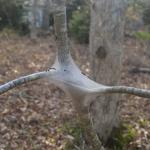 Eastern Tent Caterpillar: Malacosoma americanum eggs have hatched and small tents are being constructed by small caterpillars. Tents have been spotted in Chilmark, Middleborough, Norton, Franklin, Boylston (see Regional Report above), Northampton, and Williamsburg, MA as of 5/9/2018. Likely eastern tent caterpillar eggs have hatched anywhere they exist in the state at this time. Susceptible hosts include cherry and crabapple. Other host plants whose leaves are fed upon by this native insect can include apple, ash, birch, willow, maple, oak, poplar and witch-hazel.
Eastern Tent Caterpillar: Malacosoma americanum eggs have hatched and small tents are being constructed by small caterpillars. Tents have been spotted in Chilmark, Middleborough, Norton, Franklin, Boylston (see Regional Report above), Northampton, and Williamsburg, MA as of 5/9/2018. Likely eastern tent caterpillar eggs have hatched anywhere they exist in the state at this time. Susceptible hosts include cherry and crabapple. Other host plants whose leaves are fed upon by this native insect can include apple, ash, birch, willow, maple, oak, poplar and witch-hazel.- Elongate Hemlock Scale: Fiorinia externa is found on eastern, Carolina, and Japanese hemlock, as well as yew, spruce and fir. Crawlers will be present this month and throughout the growing season and the overlap of many developmental stages at any given time can be observed. Treatments for the crawler, or mobile, stage of this insect may be made in late May through mid-June, or between 360-700 GDD’s, base 50°F.
- Emerald Ash Borer: (Agrilus planipennis, EAB) A new detection of emerald ash borer was confirmed recently by the Massachusetts Department of Conservation and Recreation in a new community in Norfolk County, MA.A map of this location and others known across the state may be found here: https://ag.umass.edu/fact-sheets/emerald-ash-borer .
This wood-boring beetle readily attacks ash (Fraxinus spp.) including white, green and black ash and has also been found developing in white fringe tree (Chionanthus virginicus) and most recently, has been reported in cultivated olive (Olea europaea). Adult insects of this species will not be present at this time of year. Signs of an EAB infested tree may include (at this time) D-shaped exit holes in the bark (from adult emergence in previous years), “blonding” or lighter coloration of the ash bark from woodpecker feeding (chipping away of the bark as they search for larvae beneath) and serpentine galleries visible through splits in the bark from larval feeding beneath. Positive identification of an EAB-infested tree may not be possible with these signs individually on their own.
For further information about this insect, please visit: https://ag.umass.edu/fact-sheets/emerald-ash-borer . If you believe you have located EAB-infested ash trees, particularly in an area of Massachusetts not identified on the map provided, please report here: http://massnrc.org/pests/pestreports.htm .
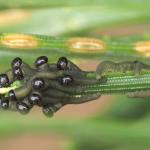
 European Pine Sawfly: Neodiprion sertifer caterpillars will be active roughly between 78-220 GDD, base 50°F. Egg hatch for this insect was observed in Framingham, MA on 5/4/2018. The primary host in MA is Mugo pine but it can be found on Scots, red, jack and Japanese red pine, but is also found on white, Austrian, ponderosa, shortleaf and pitch pine when near the aforementioned species. This dark colored caterpillar feeds in tight groups and small numbers can be pruned or plucked out of host plants and destroyed. Larger numbers can be treated with an insecticidal soap spray when the caterpillars are still small. Spinosad products can be used whenever the caterpillars are actively feeding, usually by mid-May and when caterpillars are still small. Bacillus thuringiensis Kurstaki is not effective against sawflies.
European Pine Sawfly: Neodiprion sertifer caterpillars will be active roughly between 78-220 GDD, base 50°F. Egg hatch for this insect was observed in Framingham, MA on 5/4/2018. The primary host in MA is Mugo pine but it can be found on Scots, red, jack and Japanese red pine, but is also found on white, Austrian, ponderosa, shortleaf and pitch pine when near the aforementioned species. This dark colored caterpillar feeds in tight groups and small numbers can be pruned or plucked out of host plants and destroyed. Larger numbers can be treated with an insecticidal soap spray when the caterpillars are still small. Spinosad products can be used whenever the caterpillars are actively feeding, usually by mid-May and when caterpillars are still small. Bacillus thuringiensis Kurstaki is not effective against sawflies.- Forest Tent Caterpillar: Malacosoma disstria egg hatch will occur between 192-363 GDD’s, base 50°F, which typically coincides with sugar maple bud break. Susceptible hosts whose leaves are fed on by this insect include oak, birch, ash, maple, elm, poplar and basswood.
- Hemlock Looper: Two species of geometrid moths in the genus Lambdina are native insects capable of defoliating eastern hemlock, balsam fir and white spruce. Adult moths lay their eggs on the trunk and limbs of hosts in September and October, and eggs will hatch by late May or early June. Monitor susceptible hosts for small, inch-worm like caterpillars. Where populations are low no management is necessary.
- Hemlock Woolly Adelgid: Adelges tsugae is present on eastern and Carolina hemlock. Infested trees may be treated with foliar sprays in late April to early May, using Japanese quince as a phenological indicator. Look for the females covered in a white, woolly, waxy material and settled at the base of hemlock needles.
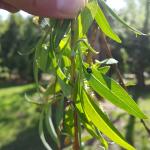
 Imported Willow Leaf Beetle: Plagiodera versicolora overwintered adults are present and have been reported as active and found on willow foliage on 5/2/2018 in Hanson, MA and were observed feeding on and mating on willow foliage in Chesterfield, MA on 5/9/2018. Adult beetles will chew holes and notches in the leaves of willow. Egg laying will continue through the end of this month. Females lay yellow eggs in clusters on the undersides of leaves. Larvae are slug-like and bluish-green in color. They will feed in clusters and skeletonize the leaves. Most plants can tolerate the feeding from this insect, and foliage will appear brown. Repeated yearly feeding can be an issue, in which case management of the young larvae may be necessary. Take care with treatment in areas near water.
Imported Willow Leaf Beetle: Plagiodera versicolora overwintered adults are present and have been reported as active and found on willow foliage on 5/2/2018 in Hanson, MA and were observed feeding on and mating on willow foliage in Chesterfield, MA on 5/9/2018. Adult beetles will chew holes and notches in the leaves of willow. Egg laying will continue through the end of this month. Females lay yellow eggs in clusters on the undersides of leaves. Larvae are slug-like and bluish-green in color. They will feed in clusters and skeletonize the leaves. Most plants can tolerate the feeding from this insect, and foliage will appear brown. Repeated yearly feeding can be an issue, in which case management of the young larvae may be necessary. Take care with treatment in areas near water.
- Lily Leaf Beetle: Lilioceris lilii overwintering adults have been spotted by scouts in central Massachusetts (Worcester County) and adult beetles were seen feeding on and hiding in new host plant foliage in Amherst, MA on 5/2/2018. Adults overwintered in sheltered places and are now active with the warm temperatures. As soon as susceptible hosts such as Lilium spp. (Turk’s cap, tiger, Easter, Asiatic and Oriental lilies) and Fritillaria spp. break through the ground, the adult lily leaf beetles are known to feed on the new foliage. (Note: daylilies are not hosts.) Typically, in May, mating will occur and each female will begin to lay 250-450 eggs in neat rows on the underside of the foliage. If there are only a few plants in the garden, hand picking and destroying overwintering adults can help reduce local garden-level populations at this time.
- Snowball Aphid: Neoceruraphis viburnicola becomes active on certain species of viburnum roughly between 148-298 GDD’s or around redbud bloom. This insect is particularly noticeable on V. opulus, V. prunifolium and V. acerifolia. Stem mothers, appearing blueish-white, can be found in curled up and distorted foliage. Damage caused by this insect pest is mostly aesthetic. Snowball aphid activity and the associated leaf distortion on susceptible viburnum has been reported in Acton, MA as of 5/9/18. For more information, please see the Regional Reports above.
- Spotted Lanternfly: (Lycorma delicatula, SLF) is not known to occur in Massachusetts. This insect is a member of the Order Hemiptera (true bugs, cicadas, hoppers, aphids and others) and the Family Fulgoridae, also known as planthoppers. This insect is a non-native species first detected in the United States in Berks County, Pennsylvania and confirmed on September 22, 2014. Until November 2017, this invasive insect was only known to Pennsylvania. It has now been reported from Delaware (November 20, 2017), New York (November 29, 2017) and most recently in Virginia (January 10, 2018). The Delaware Department of Agriculture announced the finding of a single female spotted lanternfly in New Castle County in the Wilmington, Delaware area. At this time, officials in Delaware note that it is unclear if this individual was an accidental hitchhiker or evidence of an established population in the state. For more information about the find in Delaware, visit: https://news.delaware.gov/2017/11/20/spotted-lanternfly-confirmed-delaware/ . The New York State Department of Agriculture and Markets reported on November 29, 2017 the finding of a single dead individual spotted lanternfly in the state from earlier in the month. A single dead specimen was confirmed at a facility in Delaware County, New York, which is located south-west of Albany. The NYS Dept. of Agriculture and Markets states that this dead individual may have come in on an interstate shipment. For more information about the find in New York, visit: https://www.agriculture.ny.gov/AD/release.asp?ReleaseID=3637 . Most recently, Virginia Cooperative Extension announced the finding of a spotted lanternfly population in Frederick County, Virginia on January 10, 2018. It was noted that at the location in Virginia, numerous adult lanternflies and egg masses were discovered, in addition to more at another site approximately 400 yards away. For more information about the find in Virginia, visit: https://ext.vt.edu/agriculture/commercial-horticulture/spotted-lanternfly.html .
The spotted lanternfly is considered native to China, India and Vietnam. It has been introduced as a non-native insect to South Korea and Japan prior to its detection in the United States. In South Korea, it is considered invasive and a pest of grapes and peaches. The spotted lanternfly has been reported from over 70 species of plants, including the following: tree of heaven (Ailanthus altissima) (preferred host), apple (Malus spp.), plum, cherry, peach, apricot (Prunus spp.), grape (Vitis spp.), pine (Pinus spp.), pignut hickory (Carya glabra), sassafras (Sassafras albidum), serviceberry (Amelanchier spp.), slippery elm (Ulmus rubra), tulip poplar (Liriodendron tulipifera), white ash (Fraxinus americana), willow (Salix spp.), American beech (Fagus grandifolia), American linden (Tilia americana), American sycamore (Platanus occidentalis), big-toothed aspen (Populus grandidentata), black birch (Betula lenta), black cherry (Prunus serotina), black gum (Nyssa sylvatica), black walnut (Juglans nigra), dogwood (Cornus spp.), Japanese snowbell (Styrax japonicus), maple (Acer spp.), oak (Quercus spp.) and paper birch (Betula papyrifera).
The adults and immatures of this species damage host plants by feeding on sap from stems, leaves and the trunks of trees. In the springtime in Pennsylvania (late April - mid-May), nymphs (immatures) are found on smaller plants and vines and new growth of trees and shrubs. Third and fourth instar nymphs migrate to the tree of heaven and are observed feeding on trunks and branches. Trees may be found with sap weeping from the wounds caused by the insect’s feeding. The sugary secretions (excrement) created by this insect may coat the host plant, later leading to the growth of sooty mold. Insects such as wasps, hornets, bees and ants may also be attracted to the sugary waste created by the lanternflies, or sap weeping from open wounds in the host plant. Host plants have been described as giving off a fermented odor when this insect is present.
Adults are present by the middle of July in Pennsylvania and begin laying eggs by late September and continue laying eggs through late November and even early December in that state. Adults may be found on the trunks of trees such as the tree of heaven or other host plants growing in close proximity to them. Egg masses of this insect are gray in color and look similar to gypsy moth egg masses.
Host plants, bricks, stone, lawn furniture, recreational vehicles and other smooth surfaces can be inspected for egg masses. Egg masses laid on outdoor residential items such as those listed above may pose the greatest threat for spreading this insect via human aided movement.
For more information about the spotted lanternfly, visit this fact sheet: https://ag.umass.edu/landscape/fact-sheets/spotted-lanternfly .
- Spruce Spider Mite: Oligonychus ununguis is a cool-season mite that becomes active in the spring from tiny eggs that have overwintered on host plants. Hosts include spruce, arborvitae, juniper, hemlock, pine, Douglas-fir and occasionally other conifers. This particular species becomes active in the spring and can feed, develop and reproduce through roughly June. When hot, dry summer conditions begin, this spider mite will enter a summer-time dormant period (aestivation) until cooler temperatures return in the fall. This particular mite may prefer older needles to newer ones for food. When damaging spruce spider mite populations are known from last season, dormant oil applications can be made (when temperatures are appropriate according to label instructions) between 7-121 GDD’s, base 50°F. Magnification is required to view spruce spider mite eggs. Tapping host plant branches over white paper may be a useful tool when scouting for spider mite presence. (View with a hand lens.) Spider mite damage may appear on host plant needles as yellow stippling and occasionally fine silk webbing is visible.
 Viburnum Leaf Beetle: Pyrrhalta viburni is a beetle in the family Chrysomelidae that is native to Europe, but was found in Massachusetts in 2004. Viburnum leaf beetle egg hatch was observed in Boston, MA on 5/4/2018. Tiny leaf beetle larvae can be seen feeding on the undersides of foliage at this time. This beetle feeds exclusively on many different species of viburnum, which includes, but is not limited to, susceptible plants such as V. dentatum, V. nudum, V. opulus, V. propinquum and V. rafinesquianum. Larvae, when they are present, may be treated with a product containing spinosad once they appear. Some viburnum have been observed to have varying levels of resistance to this insect, including but not limited to V. bodnantense, V. carlesii, V. davidii, V. plicatum, V. rhytidophyllum, V. setigerum and V. sieboldii. More information about viburnum leaf beetle may be found at http://www.hort.cornell.edu/vlb/ .
Viburnum Leaf Beetle: Pyrrhalta viburni is a beetle in the family Chrysomelidae that is native to Europe, but was found in Massachusetts in 2004. Viburnum leaf beetle egg hatch was observed in Boston, MA on 5/4/2018. Tiny leaf beetle larvae can be seen feeding on the undersides of foliage at this time. This beetle feeds exclusively on many different species of viburnum, which includes, but is not limited to, susceptible plants such as V. dentatum, V. nudum, V. opulus, V. propinquum and V. rafinesquianum. Larvae, when they are present, may be treated with a product containing spinosad once they appear. Some viburnum have been observed to have varying levels of resistance to this insect, including but not limited to V. bodnantense, V. carlesii, V. davidii, V. plicatum, V. rhytidophyllum, V. setigerum and V. sieboldii. More information about viburnum leaf beetle may be found at http://www.hort.cornell.edu/vlb/ .
- White Spotted Pine Sawyer (WSPS): Monochamus scutellatus will be pupating this month and adults can emerge in late May throughout July, depending on local temperatures. This is a native insect in Massachusetts and is usually not a pest. Larvae develop in weakened or recently dead conifers, particularly eastern white pine (Pinus strobus). However, the white spotted pine sawyer looks very similar to the invasive Asian Longhorned Beetle, Anoplophora glabripennis, ALB. ALB adults do not emerge in Massachusetts until July and August. Beginning in July, look for the key difference between WSPS and ALB adults, which is a white spot in the top center of the wing covers (the scutellum) on the back of the beetle. White spotted pine sawyer will have this white spot, whereas Asian longhorned beetle will not. Both insects can have other white spots on the rest of their wing covers; however, the difference in the color of the scutellum is a key characteristic. See the Asian longhorned beetle entry above for more information about that non-native insect.
- Woolly Elm Aphid: Eriosoma americanum females lay a single egg in the cracks and crevices of elm bark, where the egg overwinters. Eggs hatch on elm in the spring as leaves are unfolding. Aphids may be active from 121-246 GDD’s, base 50°F on elm. A young, wingless female hatched from the egg feeds on the underside of leaf tissue. This female aphid matures and gives birth to 200 young, all females, without mating. These aphids feed and the elm leaf curls around them and protects them. By the end of June winged migrants mature and find serviceberry hosts. Another set of females is produced. These new females crawl to and begin feeding on the roots of serviceberry. Multiple generations occur on the roots of serviceberry through the summer.
Concerned that you may have found an invasive insect or suspicious damage caused by one? Need to report a pest sighting? If so, please visit the Massachusetts Introduced Pests Outreach Project: http://massnrc.org/pests/pestreports.htm .
A note about Tick Awareness: deer ticks (Ixodes scapularis), the American dog tick (Dermacentor variabilis), and the lone star tick (Amblyomma americanum) are all found throughout Massachusetts. Each can carry their own complement of diseases. Anyone working in tick habitats (wood-line areas, forested areas, and landscaped areas with ground cover) should check themselves regularly for ticks while practicing preventative measures. Have a tick and need it tested? Visit the web page of the UMass Laboratory of Medical Zoology (https://www.tickreport.com/) and click on the red Test a Tick button for more information.
Reported by Tawny Simisky, Extension Entomologist, UMass Extension Landscape, Nursery, & Urban Forestry Program
Weeds
Japanese knotweed, Polygonum cuspidatum, has begun to emerge from rhizomes. Do not attempt to control this weed at this time as herbicide applications are not effective. Repeat cutting or mowing can be used as a non-chemical strategy and if that is the control strategy selected then cutting and mowing should begin now. Repeat cutting or mowing should be done as regrowth reaches 4 to 6 inches.
Inspect areas of landscape where new trees or shrubs, especially those that were field grown, have been planted in the last year. Look for perennial weeds that may be growing from the root ball. Canada thistle, mugwort, quackgrass, bindweed and horsenettle are some of the possible culprits. Applications of glyphosate as a directed spray should be done at the first sign of new season growth.
Treat winter annual and perennial weeds in ornamental beds with glyphosate (Roundup Pro or equivalent) and glufosinate (Finale). These applications are easier if done now before woody ornamentals leaf-out. The new growth of herbaceous perennial ornamentals can be very susceptible to spray drift, so exercise extreme caution. Non-chemical products containing clove oil, citric acid, acetic acid or orange extract can be used on small winter annuals but not on large winter annuals or perennials. Remember these organic/non-chemical products do not translocate and will not control established perennial weeds but will control young winter annual weeds. Many winter annuals are just beginning to flower and have not set seed and should be controlled now.
Landscape mulch should be the first defense against weeds in landscape beds. Application of mulch can be done at the beginning of the season before summer annual weeds germinate. Freshly mulched landscape beds will not require a preemergence herbicide application because the fresh mulch should supply adequate control of summer annual weeds in the short term. Preemergence herbicide application should be considered for mulch areas that have not been freshly mulched or a bit later in the season. Preemergence herbicides should be applied on top of landscape mulches not underneath. Freehand (dimethenamid + pendimethalin) or Tower (dimethenamid only) are great product choices for landscape beds where yellow nutsedge is a problem.
Report by Randy Prostak, Weed Specialist, UMass Extension Landscape, Nursery and Urban Forestry Program
Plant of the Week
A fragrant springtime favorite coming into bloom just in time for a Mother’s Day bouquet. https://extension.umass.edu/plant-identification/lilac
Report by Mandy Bayer, Extension Assistant Professor of Sustainable Landscape Horticulture, UMass Stockbridge School of Agriculture
Other Relevant News/Pest Alerts
What are the most common shrubs used in Massachusetts landscapes? What shrubs are underutilized?
Please let us know in a brief survey! https://goo.gl/forms/OXe9ArhYFWe8QJAo1
Information from this survey will be used to inform research and educational efforts at UMass.
Additional Resources
To receive immediate notification when the next Landscape Message update is posted, be sure to join our e-mail list and follow us on Facebook and Twitter.
For a complete listing of upcoming events, see our Upcoming Educational Events page.
For commercial growers of greenhouse crops and flowers - Check out UMass Extension's Greenhouse Update website
For professional turf managers - Check out Turf Management Updates
For home gardeners and garden retailers - Check out home lawn and garden resources. UMass Extension also has a Twitter feed that provides timely, daily gardening tips, sunrise and sunset times to home gardeners, see https://twitter.com/UMassGardenClip
Diagnostic Services
A UMass Laboratory Diagnoses Landscape and Turf Problems - The UMass Extension Plant Diagnostic Lab is available to serve commercial landscape contractors, turf managers, arborists, nurseries and other green industry professionals. It provides woody plant and turf disease analysis, woody plant and turf insect identification, turfgrass identification, weed identification, and offers a report of pest management strategies that are research based, economically sound and environmentally appropriate for the situation. Accurate diagnosis for a turf or landscape problem can often eliminate or reduce the need for pesticide use. For sampling procedures, detailed submission instructions and a list of fees, see Plant Diagnostics Laboratory
Soil and Plant Nutrient Testing - The University of Massachusetts Soil and Plant Nutrient Testing Laboratory is located on the campus of The University of Massachusetts at Amherst. Testing services are available to all. The function of the Soil and Plant Nutrient Testing Laboratory is to provide test results and recommendations that lead to the wise and economical use of soils and soil amendments. For complete information, visit the UMass Soil and Plant Nutrient Testing Laboratory web site. Alternatively, call the lab at (413) 545-2311.
Ticks are active at this time! Remember to take appropriate precautions when working and playing outdoors, and conduct daily tick checks. UMass tests ticks for the presence of Lyme disease and other disease pathogens. Learn more
